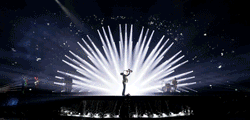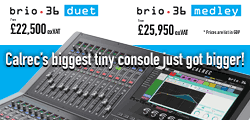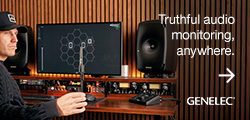![]() Your last recording session may have used virtual mics and outboard. The guitar amps, as well as mic positioning, may have been similarly virtual. Alternatively, you may have been placing real mics around a live band before settling down in the control room. Something a bit more ‘real’.
Your last recording session may have used virtual mics and outboard. The guitar amps, as well as mic positioning, may have been similarly virtual. Alternatively, you may have been placing real mics around a live band before settling down in the control room. Something a bit more ‘real’.
Very real and very fundamental, Duncan Miller’s most recent sessions returned him to a time when there were no microphones…
Miller owns and operates the Vulcan Cylinder Record Company, which specialises in making acoustic recordings. One of his recent sessions was at the Royal College of Music recording studio, where he was using a wax cylinder recorder and an entirely acoustic audio path – effectively a state-of-the-art set-up for 1904. Members of the APRS came in to see how it was… before there were mics.
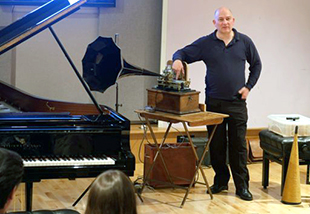
The recorder used was adapted from a Parlophone dictation machine (c1920) with a longer mandrel for master cylinder blanks, and a large flywheel with an external speed-controlled DC motor. The machine has a trunion, a device to allow the recorder or cutting head to move freely up and down with minor variations of the blank surface, while providing and airtight – and thus sound-tight – connection with the recording horn.
For playback, he had an Edison Fireside model phonograph, circa 1909, with a ten-panel cygnet horn, representative of the time when cylinders were mass-produced from moulds derived from master recordings.
The wax cylinders he uses are 55mm in diameter and 120mm long, with a tapered core to fit the mandrel of the recording machine. They are composed of a metallic insoluble soap compound produced by a balanced chemical process to provide a stable, smooth and amorphous material that is soft enough to cut easily, yet hard enough to play back and be processed into a mould to produce final recordings. Before use, these blanks are shaved to a near mirror finish at high speed using a polished sapphire blade.
To begin the Royal College of Music session, Miller took time out to underline the analogue nature of the process to his audience, and to explain that the mechanical storage directly represents the shape of the waveform displayed on a digital editing screen – without the intervening conversion into bits and back that we have come to accept.
Session work
Beginning with a Chopin piece played on a Steinway D grand piano by Otis Beasley, Miller selected a cutter head with a diaphragm that, in combination with the selected horn, produced the most pleasing results on playback. ‘The aim is to transmit enough of the sound energy to the thin glass diaphragm to produce sensible changes in the depth of the groove cut by the stylus attached to its centre and resting on the wax cylinder’s surface,’ he explains. ‘The cut needs to be sufficient to play back without the need for amplification (not a commercial option in the early 1900s), but not so great that the stylus lifts from the surface of the wax blank, as this causes an unpleasant single-sided clipping effect called “blasting”.’
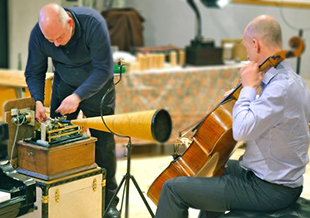
The experimentation required can be compared to selecting the type and position of microphones used in an ‘electric’ recording studio. Once understood these choices can be repeated in day-to-day recording. Then as now, hiring an experienced recording engineer saved considerable time and money.
When recording a grand piano, the principal problem is that the sound is non-directional and fairly widely spread, prompting Miller to select a larger flared horn and direct it at the raised lid. ‘Some horns are angled at the end and were also used commercially, pointed directly at the piano strings,’ he says. ‘Recording the piano being played at its full piano-forte range of dynamics highlights the limitations of the acoustic recording, in that the quiet parts tend to be lost in the inherent cutter noise of the wax, while loud parts suffer the blasting alluded to earlier.’
When working with a recorder that has no technical provision for eliminating the blast, some engineers would add working weight, but this restricts diaphragm movement and causes groove-to-groove echo. The alternative is to direct the pianist to play the soft parts louder and the loud parts softer – similar in some ways to the ‘mic technique’ used by some singers to reduce the dynamic range of a performance at the mic.
It is worth noting here that the dynamic range of a typical acoustic studio upright piano is generally narrower than that of a grand piano.
Back in the Royal College of Music recording studio, Miller had settled on a fairly satisfactory result that was played back on the Edison Fireside machine. The cylinders being used were in the two-minute format (100 TPI 160rpm), so the piece was edited down to two minutes from four. ‘Selecting how to do this and retain the essential elements of the piece is always difficult,’ he says. ‘In 1904 – the date that I have chosen to represent in these demonstrations – the average customer was probably looking for variety and novelty rather than any desire to collect longer performances in two-minute sections.’
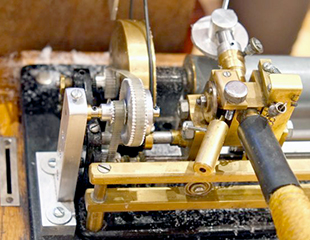
Some recordings were made as ‘partworks’. In 1906, a set of cylinders of HMS Pinafore were produced by the Sterling Company, but discs more readily lent themselves to being grouped in sets in bound sleeves – being reminiscent of the photograph albums that were popular in the late Victorian and early Edwardian era, this gave rise to the term ‘album’ that remains current even with downloads.
From the piano, Miller moved to soprano Coline Infante with piano accompaniment from Gen Tomuro. For this, he used an advanced ball recorder, so-called not because it was technically advanced but because the weight of the recorder was supported on a polished ball running in advance of the cutting stylus, with a micrometer screw to determine accurate depth setting for the cut. Also, and most importantly, this reduced the possibility of then stylus leaving the record surface. It is, however, very much more difficult to set up and needs near-perfect cylinder surfaces to work at all.
‘We also needed to enlist another device at this point – the studio assistant, who moves singers back during loud bits,’ Miller explains. ‘As the piano is to be the accompaniment, a smaller, narrower horn can be used to focus on the soprano with the lid of the piano behind her. Quick changes of set-up and subject are not the most straightforward of things to do, so changes of recording machine height and horn cranes were needed, as the subject would now be at head height rather than piano height.’
‘Important negotiations’ with the pianist were required to ensure that he would play loudly throughout, as the sensitivity of the horn and the distance from the piano to the horn demanded. ‘We then made a recording which showed technical promise, although in the real studio, we would have spent r
‘In a cylinder recording studio, horn suspension from the ceiling was common and articulated rods sticking out from a wall bracket were used,’ he adds. ‘In some old photos, these look as if the engineer is about to hang out the weekly wash on them, but they are strictly functional.’ather more time and, hopefully, made several takes of several songs,’ Miller says.
The following session was for a violin and its 1900s high-tech cousin, the Stroh violin – fitted with a horn of its own. ‘The violin is not a very directional instrument and, especially in ensemble work, it can get lost in the acoustic recording process,’ Miller explains.
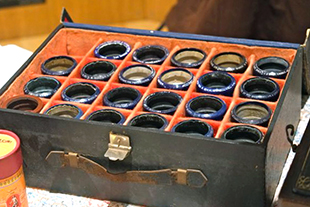
An expert in all things Stroh, Aleks Kolkowski (who was behind the Science Museum’s In Search of Perfect Sound installation) demonstrated both types of instrument at similar distances from the recording horn to show the extra ‘punch’ available from the Stroh with its directional horn output. He explained that the instrument – indeed the family of instruments – was developed independently from its later use in the recording studio. ‘By the period we were representing, however, they had become an essential piece of recording equipment,’ Miller says.
The session continued with Professor Neil Heyde taking up the cello, and Miller using a different horn and placing the recording machine nearer floor level so that the horn could be directly aimed at the cello’s f-holes.
On the record
Where the recording methodology of these early recording sessions laid some of the foundations for the ‘electric’ recording processes that were to follow, their release to the public also helped define formats and terminology.
‘It is a misconception that cylinders were produced only by direct recording; this was the case only in the first couple of years when production was on a modest scale,’ Miller offers, by way of insight into the earliest stage of music recording. ‘The process of mechanical duplication (akin to high-speed cassette tape copying of more recent times) was initially called “doubling” since you now had two copies rather than one. Rumour has it that the word was contracted to “dubbing”, as used in the recording engineers’ lexicon today. The process of what is known as pantographic copying was the result of an enterprising engineer and music industry proto-pirate called Frank Capps. He was in the habit of hiring cylinders for the weekend – you could do that in the early 1890s. 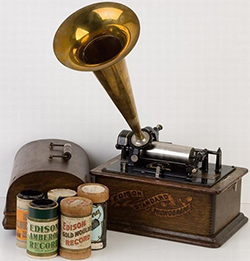 However, in his era, blank records were less than consistent in colour, shades depending on the cooking time of the soap material and used to make them. Someone at the shop where he hired them noticed that the returned records were a different colour from the hired ones. On following up this discovery, it was decided to pay Capps for the invention of the duplicator – which meant around 30-plus copies per master record, while still cutting between six and 20 masters per performance from a group of recording machines. This sufficed until 1901-2, when the more sophisticated gold moulded process came in.
However, in his era, blank records were less than consistent in colour, shades depending on the cooking time of the soap material and used to make them. Someone at the shop where he hired them noticed that the returned records were a different colour from the hired ones. On following up this discovery, it was decided to pay Capps for the invention of the duplicator – which meant around 30-plus copies per master record, while still cutting between six and 20 masters per performance from a group of recording machines. This sufficed until 1901-2, when the more sophisticated gold moulded process came in.
‘True master records could now be engineered and the approved take made into negative metal moulds electroformed in copper on to the wax surface, previously coated with gold under vacuum to render it conductive. Artistes’ fatigue was reduced at a stroke, but so was their income from repeat sessions. Engineering stress probably increased as the master needed to be perfect and to survive the post-cutting processes. Because the pressing process for discs at this time was similar, the same could be said for them. Early moulded records were made of a slightly harder wax than the mechanically duplicated ones and eventually this was replaced by moulded plastic in the shape of celluloid.
‘The examples we played at the Royal College of Music show that it is still possible to make a satisfying record using non-electrical methods. Historically, the owner of a good phonograph or gramophone was seldom being short-changed when purchasing a new recording. The ravages of time and low expectation of quality from the early recording era, along with poor transfer methods, have often given the impression of this being a “dark age” in recording. Rather, it was a period when the recording studio was invented and the requirements of producing a master record for later mass consumption were defined.
‘In 1904, cylinders of popular numbers sold in the tens of hundreds of copies. Edison Bell produced 75 moulds of Florrie Ford singing ‘Down at the Old Bull and Bush’. By my estimate of output capability, this would have produced around 100 copies per hour. I chose 1904 as the reference point for our session since the price of records and machines was, by then, within the reach of most working people and the demand was there.’
Duncan's thanks are due to Dr Amy Blier-Carruthers of Royal Academy of Music, who organised the performers from her students and staff members.




